By Joshua Farnsworth
In this article (and in the video above) I share my experience of hiring a local portable bandsaw mill owner to help me transform a fallen 155 year old white oak tree into gorgeous and affordable quarter sawn wood, like this:

Quarter sawn white oak lumber is one of the most beautiful lumbers for furniture because of it’s lovely figure. In this video and article Todd Horne and I share great advice for turning your trees into great custom bandsaw mill cut lumber, at a reasonable price.

And after you finish reading this article, be sure to also check out my article titled: “How to Choose Wood Lumber for Woodworking: 7 Easy Steps“.
Finding my Massive White Oak Tree

Before I jump into how we used a portable bandsaw mill to make quarter sawn white oak lumber, I’d like to explain how I got this massive white oak tree for free: My friend Jeremy invited me to scavenge free white oak firewood from a “big” tree that had fallen across his friend’s driveway in downtown Charlottesville, Virginia. I jumped at the chance for free oak firewood.

When I arrived at the site I wasn’t looking at the twisted 2-foot wide firewood branches that Jeremy had started cutting. I was staring at the lovely, mostly straight base of the tree. I measured the tree base and my eyes almost popped out of their sockets.

Four feet wide! I just knew that I couldn’t pass up this opportunity to get a bunch of very wide quarter sawn white oak lumber for cheap. So I called my friend Todd to ask him to bring his portable bandsaw mill so we could create some quarter sawn wood so I could make some lovely furniture (see the figure below).

If you don’t have logs for milling up your own lumber, there are other solutions. Oftentimes portable bandsaw mill owners will have a great collection of logs that they’ve piled up over the years. If they happen to have the type of log you’re looking for, then this is a great option, because you’ll avoid travel fees and extra hourly charges.

But if they don’t have what you’re looking for, then you can find a log of your choice at a local log yard. Last time I checked, you could get a nice oak log loaded onto your trailer for around $100. You can read our article and watch our video titled: “How to Choose a Log at the Log Yard with Elia Bizzarri.”
Preparing the Log for the Portable Bandsaw Mill

In preparation for Todd’s arrival, I decided to work on extracting the best 10-foot section from the base of the tree. My old Husqvarna chainsaw had given up the ghost the day earlier when I was cutting the branches for firewood, so I returned the next day with a much better new Echo chainsaw (here’s my Timber Wolf model). My new chainsaw turned out to be a formidable foe against the tree’s wide trunk. (Tool advice: this Echo chainsaw model is the highest you can go in the consumer category, but it has the pro chainsaw engine, along with the best warranty…5 years…that’s what sold me. Years later and it’s still working great).

It was funny that the most challenging part wasn’t cutting this 36-inch + wide relief section with the chainsaw, but getting it unstuck!

After I got the relief piece unstuck, Todd arrived with his portable bandsaw mill, and we worked with our chainsaws on the last cut; cutting out the 10-foot section that we planned on milling into boards.

Once the final cut was made, the 10,000 pound log thudded to the ground, and the trunk & roots shot straight up!

After counting the rings on the tree, I discovered that the tree started growing 155 years earlier, right during the Civil War! Soldiers would have been marching right near the sapling tree.

Now that the huge log was free from the tree, it was time for Todd and I to safely move the very heavy log down the slope of the yard, being extra cautious so it wouldn’t crash into cars or a house. Getting the huge log down the hill was no easy feat, but suffice it to say that we had a very difficult time safely rolling this 10,000 pound+ log. We set up stumps to prevent the log from rolling into the street, and then got to work.
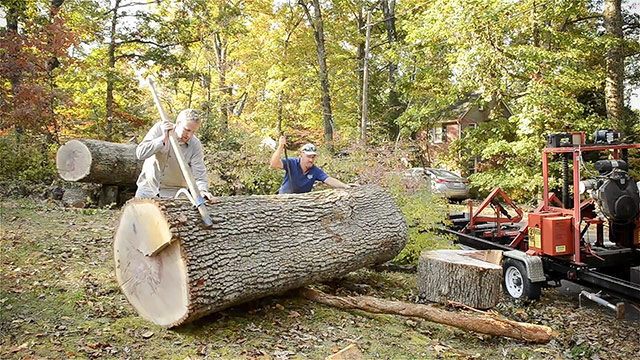
I had used a log Cant hook before, but never on a log this heavy. I was amazed at how leverage can be so efficient in moving such a large object! At one point we had to hook a chain onto the log, and I used my pickup truck to pull one end around so we would have a straight path to the portable bandsaw mill:

In the end, it was a beautiful site to see the 10-foot log gone from the driveway and at the base of the bandsaw mill.
RELATED
How to Choose a Log at the Log Yard with Elia Bizzarri
How to Choose Wood Lumber for Woodworking
How to Square Boards for Woodworking with Power Tools
How to Square, Flatten, and Dimension Rough Boards with Hand Tools
How to Make Figured Maple Pop!
Loading the Log onto the Portable Bandsaw Mill

Once we finished the dangerous job of rolling the enormous log down the hill, we thought the job would be a breeze going forward. We were wrong. Logs of “normal” size can easily be lifted up onto the portable bandsaw mill using the hydraulic arms. But Todd had never attempted to lift a log of this girth onto his bandsaw mill. But Todd is a smart guy, so we used a series of jacks and wooden skids to get the log onto the portable bandsaw mill’s hydraulic arms.
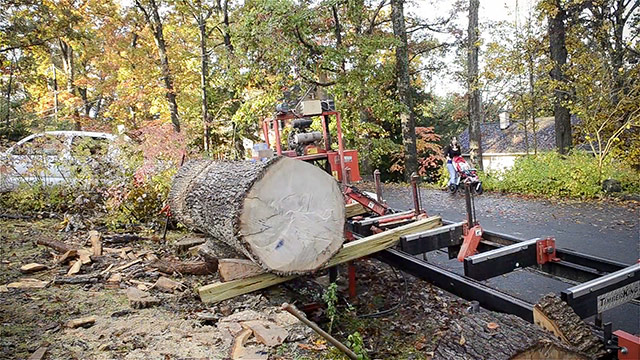
And then Todd used the precise controls of his bandsaw mill to carefully lift my log onto the skids using the hydraulic arms.

This was a bit of a nerve-racking operation, because we weren’t sure what the huge log would do to the bandsaw mill once the arms dumped it onto the mill. But Todd took it slow, and the log dropped perfectly into place.

Getting the Huge Log to Fit on the Bandsaw Mill

As we were getting the bandsaw mill ready to make the cuts, we quickly discovered another problem with using a log this big. It was too big for Todd’s portable bandsaw mill!

So Todd spent a good deal of time cutting notches out of the oversized log to allow the bandsaw mill head to pass over it.
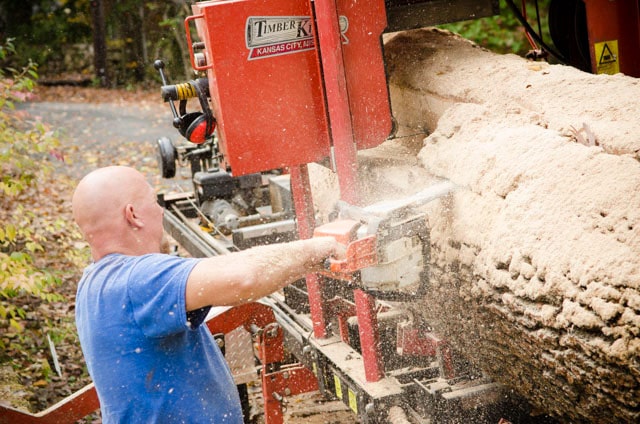
As frustrating as this was, Todd was pretty happy to get some heroic photographs of himself using a chainsaw!

FYI: all this effort isn’t typical of bandsaw milling. If you have smaller logs that are stacked in a more easily accessible location the process is actually quite fast. Most of our time was spent dealing with a 3-4 foot x 10′ log. Be smarter than me. Because of all the chainsaw trimming, the first side of the log took the longest.

But this top slab eventually became a thick workbench top, so all of the work was worth it! At least for me. I’m not sure if it was worth it for Todd.
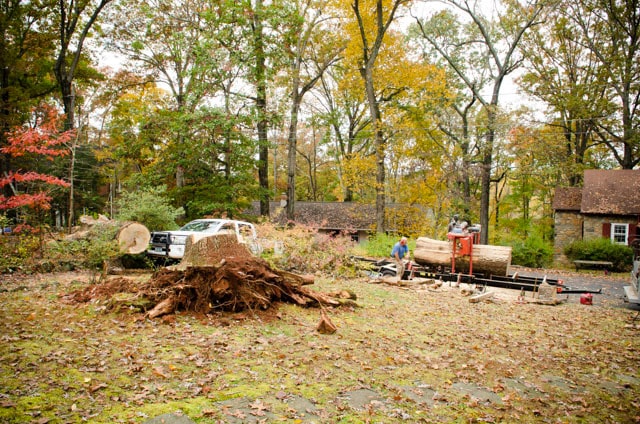
Milling Flat Sawn Boards on the Bandsaw Mill

Once the first edge was removed, Todd used the hydraulic controls to flip the flat side around, until it landed face down.

All the other cuts are squared based on this first cut.

I got some nice and wide flatsawn boards off the other three sides, while turning the log into a square billet in preparation for the quarter sawing process:

Flat sawn boards aren’t as stable as quarter sawn wood, but for most applications it works just fine. These boards have a nice cathedral figure.

Milling Quarter Sawn White Oak Lumber on the Bandsaw Mill

After we squared all four sides of the log, we had a huge square billet, all ready for extracting quarter sawn wood.

You can see here how the flat sides sit snugly against the bandsaw mill in preparation for accurate square cuts:

Next, Todd ran the bandsaw mill head over the square billet to divide it in half to get two equally sized rectangular billets.

Then he rotated the lumber and cut the billets in half again, providing four equally-sized quarter pieces of white oak lumber:
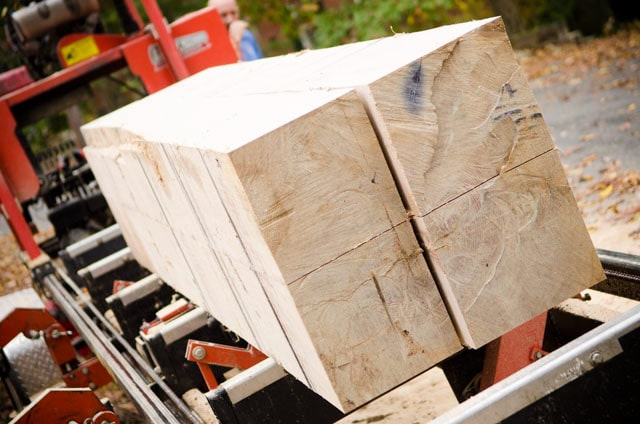
Once we got the log quartered we loaded the four very heavy pieces in Todd’s truck and drove them to his property.

Several weeks later I went over to Todd’s place, and we sliced each of the four billets into highly-figured quarter sawn white oak lumber. You can see the nice figure here:
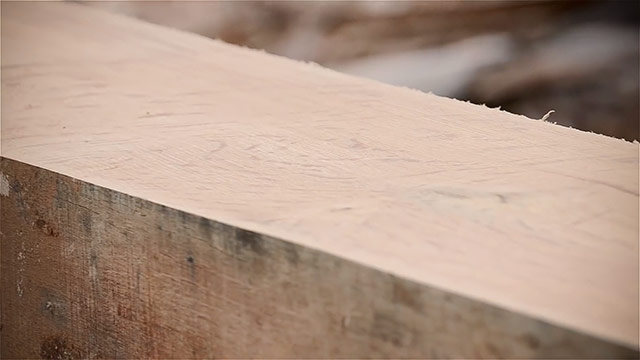
I did cut a couple of slabs and larger 4×6 and 4×4 boards for workbenches and table legs, but most of the wood was cut into 1-inch thick quartersawn white oak wood boards:

Here’s a close-up view of the hose that cools off the blade as it slices through the hard white oak like butter:

And here’s a close-up view of some veneer pieces that we cut from one of the billets:
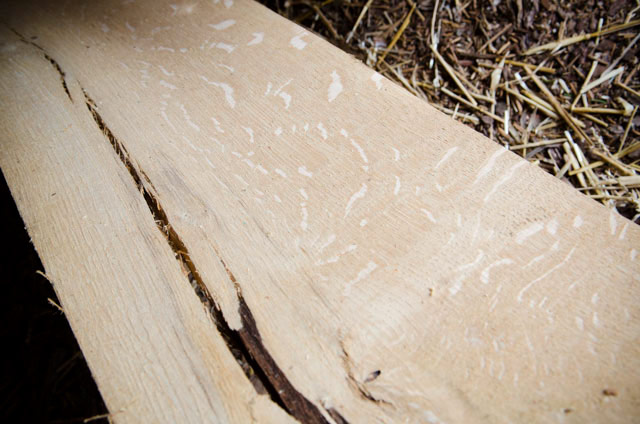
Stacking and Drying the Quarter Sawn White Oak Lumber

It took me two trips to transport all of my freshly milled quarter sawn white oak lumber back to my farm. Here’s what I did to prepare the lumber for air drying:
- I’m fortunate to have a large covered front porch to keep my lumber dry, so I stacked it under there. If you don’t have a covered space like this you can cover your stack of lumber with scrap lumber or some sort of metal or plastic roofing. Something to keep rain from pouring directly on it (like these corrugated roof panels).
- Your stack of lumber should be in a space where it’ll get plenty of air flow.
- I used cinder blocks as a base, underneath my covered front porch.
- I placed “stickers” (i.e. spacers) on the cinder blocks and in between each layer of lumber. Most of these stickers were scrap cutoffs from the wall battens of my workshop remodel (see the remodel here). Just make sure that the stickers are the same thickness on each layer of lumber.
- I painted the ends of the white oak boards with an end-grain sealer to prevent checking (or cracking) of the boards. This Anchorseal 2 stuff is what most woodworkers that I know use (click here). I probably used 1/8 of a gallon for my entire stack of lumber, so don’t buy more than you have to.
- Finally I placed some weight on the top pieces (not pictured below):

Why Mill Your Own Lumber with a Portable Bandsaw Mill?

Milling your own lumber has several advantages and disadvantages when compared with simply buying lumber at a lumber yard:

Advantages of Custom-milled lumber from a Portable Bandsaw Mill
- You get to feel really awesome and tough (this is definitely #1).
- You save a lot of money per board foot and get a lot of wood air-drying your own lumber.
- Kiln dried wood is usually more brittle and prone to chipping than air-dried lumber when being worked with hand tools or power tools. In my opinion the lumber industry has tried to make furniture makers believe that their kiln-dried wood is superior. But historically all wood was air-dried. Most of the best wooden furniture ever made was built with air-dried lumber. So don’t let anyone convince you that air-dried lumber is inferior in quality.
- Air drying lumber can preserve more color than kiln drying.
- When you have a log milled, you can customize your lumber sizes. For example you can get a mix of flat sawn wood, quarter sawn wood, slabs & large pieces for building workbenches, thin veneer boards, etc.

Disdvantages of Custom-milled lumber from a Portable Bandsaw Mill
- You’ve got to wait to use your lumber. The rule of thumb is to dry most lumber at least 1 year per 1″ of thickness. Sigh.
- It takes a bit of work to move logs and lumber (but isn’t hard work satisfying?).
- If you just need a little bit of lumber for a project, it’s cheaper to simply buy your already-milled lumber.

How to Find a Portable Bandsaw Mill

If you want to mill your own custom lumber, then you have two options:
1. Hire a Portable Bandsaw Mill owner:
The cheapest option for woodworkers and Timber Framers who build on a smaller scale is to simply hire a portable bandsaw mill owner, and have them come to your site, or transport your logs to their site. The best places to find these mills is by (a) searching on Google maps for “wood mill”, (b) searching on Craigslist or Facebook Marketplace, or (c) searching on online forest products networks, like this one. Another good source that I’ve used is this directory from the U.S. Forest Service. The problem is that it hasn’t been updated since 2005. You can also ask local woodworkers which mills they’ve used.

2. Buy your own portable bandsaw mill:
If you’re serious about milling a large amount of lumber, for resale or for large construction projects, then buying your own portable bandsaw mill may be a good idea. Especially now that lumber prices have shot up during the COVID-19 pandemic.
But before you look into buying your own portable bandsaw mill, just make sure that you are interested in mechanical things, because using a portable bandsaw mill requires a lot of tweaking and repairs. Also make sure you have a good source of cheap or free lumber.
If you’re set on buying a portable sawmill, then first check prices for used portable sawmills in your area, on websites like Craigslist, Facebook Marketplace, and even websites like SawMillTrader.

Best Brands of Portable Bandsaw Mill?
I’m not going to go into specific portable bandsaw models, but I’ll share some of the most common brands of portable bandsaw mills, and you can research the models that best fit your need:
- TimberKing Portable Sawmills
- Wood-Mizer Portable Sawmills
- D&L Portable Sawmills
- Norwood Portable Sawmills
- Hud-Son Portable Sawmills
- Woodland Mills Portable Sawmills
- Any other good brands that I didn’t mention? Comment below.
Questions to Ask Before Hiring a Portable Bandsaw Sawmill
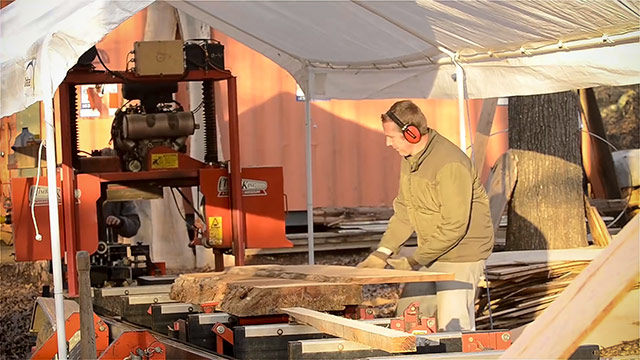
Now that you’ve heard about my journey of hiring a portable bandsaw mill operator to mill up my custom lumber, I want to talk about some of the questions that you should ask before you hire someone to mill up your trees into fine lumber.

“What’s your rate, and how do you charge?”
Some bandsaw mills charge by the hour and some charge by the number of board feet that they cut. You’ll need to do the math for your particular situation, but if someone works for you for an entire day, you’ll pay about 1/3 more if paying by the board foot. In my area the rate is around $75 to $100 per hour.
“When do you start counting your time? Do you have a traveling fee?”
Some portable band saw mill owners charge a traveling fee, or they start charging their hourly rate when they leave to drive to your location. And some (like Todd) don’t start charging you until they arrive and actually start cutting. This is important to know beforehand so you’re not surprised.
“What other fees do you have?”
Most portable bandsaw mill operators will charge a fee for a new blade if they hit any object while sawing. Todd charges $30 per blade if he hits anything, because even if the blade isn’t broken, the integrity of the blade is ruined.
“What is the minimum number of trees or hours of work?”
Some bandsaw mills aren’t willing to travel to a site and setup all their equipment just for one log or just for an hour or two of work. It’s just not worth it for them. So either plan on having multiple trees for them to cut, or be willing to pay extra for their time. As I mentioned earlier, it’s also likely that they’ll let you bring a single log to them to cut up, and if their saw is setup already, they may be flexible enough to cut up just a single log.
“What’s the largest size log you can saw on your portable bandsaw mill?”
As you noticed while reading this article, it’s pretty important to know beforehand what capacity the portable bandsaw mill can handle. We were able to still make it work, but most mill operators likely won’t be as flexible as my friend Todd. It’s important to know this before they start driving to you.
Conclusion

I hope this has been a helpful article & video for anyone hoping to mill their own lumber with a portable bandsaw mill! If you’ve got any questions or comment, please leave them at the bottom of this page.





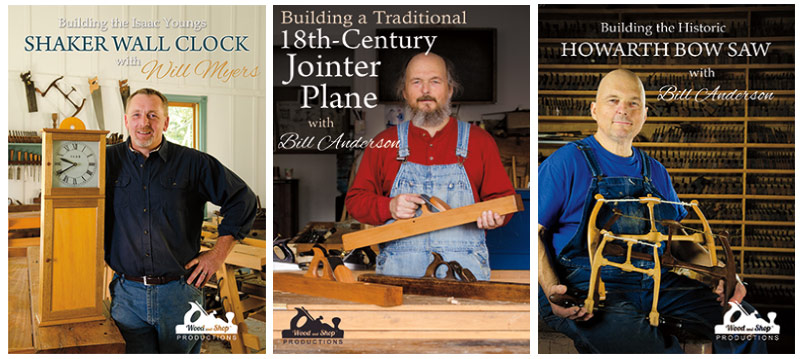
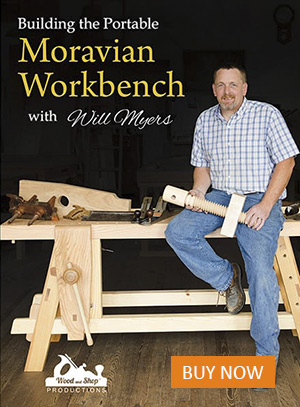






Good stuff Joshua. Nice fleck in that Oak. I’ll keep Todd in mind as I’m within range in Lynchburg.
–Bill
http://www.LineAndBerry.com
BTW: I did the dining room windsors at James Madison’s Montpelior. I figured you’ve been there since it’s not far from Earlysville.
Glad you liked it Bill! Wow, will you please share photos of your windsors? I have indeed been to Montpelior, as it’s 30 minutes from me.
Hey, good to hear from you again Bill! I didn’t know that you did the Montpelier Windsors…excellent! Yeah, it’s about 30 minutes from my shop. Mind sending me some photos? Also, I’d like to come feature you in a workshop tour next time I’m heading your way, if you’re interested?
Nice stack of wood, just beautiful. Looks like it was a lot of fun. That’s one of them character building moments for sure. I do agree 100% about getting a mobile sawmill in to mill your lumber. The fellow I used brought a tractor with forks for loading on the mill and was here for four days and milled 5000 brd ft flat sawn and good three sides. 8 to 20 ft lengths by 12 to 20 inches wide. 1… Read more »
Wow, you got a smokin’ good deal!
Don’t I know it. I built a lot of garden beds and a mighty fine chicken coop, plus a few side job projects. And still a fair pile left. Not the greatest for hand tool work, a fair few knots and such, but just fine for farm buildings. Not to mention we have been heating the house with the slab edges for three years. I have a few pics on a blog I got two posts into and got way… Read more »
That Timber King is a lot like the lumber saws that I custom make and design. Thanks for sharing!
Wow, you custom make bandsaw mills?
Wow, ok so I’m commenting to be entered to win but seriously I have been following your blog for a few years now and there has not been one post or video I haven’t wanted to read or watch at least twice. I love your blog and have suggested it to others. I try to get my husband to be as excited about working with hand tools as me and I might be wearing him down slowly. So in order:… Read more »
I am drooling over all that beautiful relatively “free” oak. Granted I realized the labor of getting it prepped and cut and put away is hardly free. But I’m just thinking of all the cool projects you will be able to do with that. I want to say thank you for doing the giveaway. I’m glad it forced me to the blog, I had really only been following you on youtube, and I didn’t realize how extensive your library is… Read more »
Your and TOdd’s complete lack of eye protection distressed me IMMENSELY and seemed VERY careless and cavalier
Yeah, eye protection is very important. I always wear eye protection when using a chainsaw, and should have worn it more near the band saw mill. In my shop I never use any power tool without eye protection.
One thing to mention is that some of the bandsaw manufacturers sites have a list of sawyers. The list states if they travel or if their setup is fixed and a number of other options. Wood-Mizer has such a list. Of course the next question is how up to date is the site. I’ve had a sawyer come onsite twice and I’ve got so much oak (mostly red) that I’ll never use it in my lifetime. Having said that, I’ve… Read more »
A great collection of lumber Mark! If you can’t use all that oak, then you could certainly sell it on Craigslist or Facebook marketplace. I didn’t do a video or article about the slabs.
Thanks Joshua! I sincerely hope that your school will come back soon, because I live only two hours from you and would love to take some of your classes. Your online content is excellent and I am sure your in-person instruction will be so as well.
We’re still trying to make a decision
If you are in Virginia, look at trees Virginia.org for a directory of sawmills searchable by location. They also list other tree businesses, like kilns and lumber.
The VA Department o Forestry is also actively promoting urban wood utilization. Check out their website too.
Cool, thanks Scott! Are you in Virginia?
I am, Smithfield in southeast VA. I work with the Department of Forestry in that area.
I appreciate the article. Wished I had found it before the neighborhood sawed up 2300 bdft! Stickering on your stack appears much wider spaced than many recommendations. Did it seem to work out? Quarter sawn does not move as much as typically done flatsawn, so maybe ok. I have a stack of 5/4 white oak that I just put up. Sticking is on 18inch centers. I have a 2ft dia cherry still waiting to be cut up when the sawer… Read more »
Hi Steve,
It worked out great for me. I think the internet is a great resource, but it also leads people to get a bit too detailed about things like stickering. So don’t worry too much about it…especially don’t worry about measuring the spacing.
Cheers,
Joshua
Hi Bill,
That was a beautiful tree, and a great find. Please let me know if you would be will to share Todd’s contact info for some work to be done.
Thank you for your help,
Mark
Looking for someone to mill some cedar trees on my place